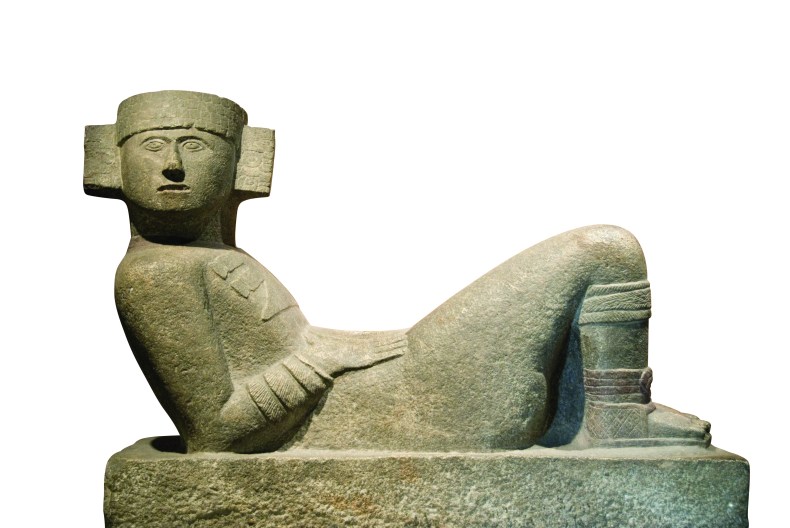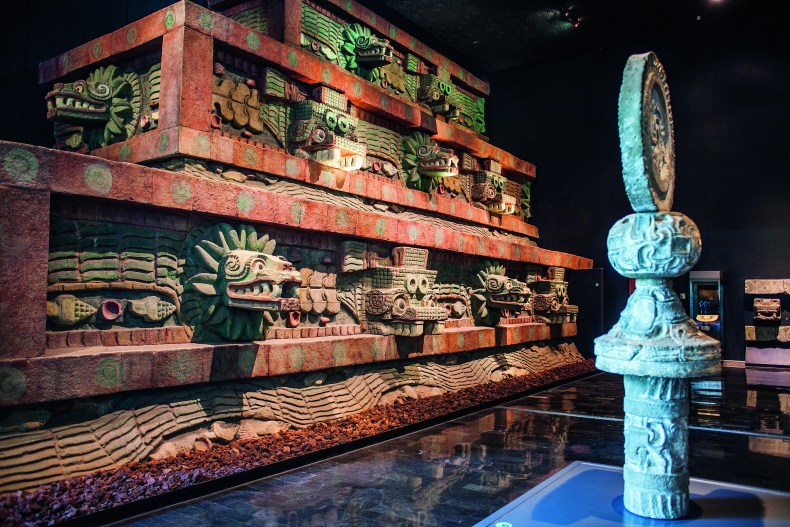The Museo Nacional de Antropología in Mexico City is often described as one of the world’s great museums, and rightly so. Housed in a series of vast galleries, designed by the architect Pedro Ramírez Vázquez, which surround a spectacular ‘umbrella’ fountain in the central courtyard, it gathers together the remnants of an entire civilisation, or rather sequence of civilisations – from the remotest period of the Olmecs, dating back to the second millennium BC, up to the Aztec empire and its brutal terminus after the arrival of the Spanish in the early 16th century.
The collection has its origins in the Museo Nacional Mexicano, established in the 19th century, the first attempt to bring together the antiquities and surviving documents of the pre-Hispanic period in modern-day Mexico and Central America. In 1964 it moved to its modern home in Chapultepec Park, a traditional retreat from the clamour of Mexico City, with the pre-Hispanic objects shown on the ground floor and on the first floor ethnographic displays that document the lives of indigenous Indians and bring the story up to the present. The connection was explicit: the ancient civilisations understood as the cultural roots of the present, and as the basis for a sense of Mexican identity cultivated during the revolution that began in 1910, and in the subsequent years of reform.
I can think of no other museum in the world that pursues such an ethnically-oriented goal – in this case creating a vision of modern Mexican identity – so programmatically, nor so effectively. When I visited in December, the museum was alive with Mexican families, absorbed by the objects on display, themselves so visually arresting as almost to need no other interpretation. They marvelled at the mysterious Olmec boulder heads, which still radiate brutal power, and at the reconstruction of the Temple of the Feathered Serpent at Teotihuacán, with its heavily stylised carvings of Quetzalcoatl, the bird-serpent god.

Chacmool figure, Early Postclassic period (c. 950–1,200), Mayan, Chichén Itzá, Yucatán. Museo Nacional de Antropologia
The Chacmool figure that so fascinated Henry Moore reclines at the centre of the extensive display on the Mayan civilisation, showing both its artistic and scientific achievements, and the vital importance of the decipherment of Mayan script in recent decades. At the heart of the museum, in a vast room at the far end of the courtyard, the Aztec empire is presented as the culmination of some 2,000 years of Mesoamerican civilisation, the displays centring around the vast ‘Sun Stone’, unearthed in the centre of Mexico City at the end of the 18th century. Nearby stands the monumental figure of Coatlicue, the Aztec goddess, mother of the sun and world-creator. Twinned rattlesnake heads rise from her severed neck, above a seething mass of sculptural life – a skirt of snakes, a string of hearts and hands dangling from a necklace, while more snakes emerge from her arms, emblazoned with monstrous faces.
The sense of continuity running through the separate cultures is remarkable. There are the common figures of the gods: the Feathered Serpent, which makes its earliest appearance with the Olmecs, is refigured by almost every subsequent culture and eventually evoked by the green quetzal-feather headdress allegedly belonging to the Aztec ruler Moctezuma, which was sent by Cortés to the king of Spain (a modern replica is displayed here; the original, which was illustrated in the November 2017 issue of Apollo, is now in the Weltmuseum in Vienna). Then there are the imagery and techniques that thread together Mesoamerican cultures: stylised animal forms, figurines carved from jade or stone, or modelled in clay, masks of humans and gods, incised standing stones, and the heavy paraphernalia of the ubiquitous ball game, with its tiny hoop through which it seems impossible that the rubber sphere ever passed. Hanging over the displays, large paintings show scenes of ancient life and provide a visual backdrop, such as the idealised view by Luis Covarrubias of the Aztec city of Tenochtitlan, floating like a Mexican Venice on Lake Texcoco, based, the label reads, ‘on descriptions bequeathed by Hernán Cortés, Bernal Díaz del Castillo, and other soldiers who, in their chronicles, depicted these indigenous cities before their destruction’.

Replica of the Temple of the Feathered Serpent in the Teohuacán gallery at the Museo Nacional de Antropología.
The story is thrillingly and convincingly told, giving the sense of a scientific mission of research into the past and of the destiny narrative of the Indian people. What would now be termed ‘identity politics’ on such a vast scale is surely a liberating force, yet also potentially isolating from more global contexts. What is striking about many of the objects on display are the parallels that can be drawn with other world cultures – with pre-Tang Chinese art, with African sculpture, or with the art of the Celtic or archaic Greek worlds. Shortly after the Museo Nacional de Antropología opened, the Museo Nacional de las Culturas del Mundo was inaugurated in the centre of Mexico City, with the task of showing world cultures; and, as the Mesoamerican expert Megan O’Neil informed me, when I raised the question of isolation, displays at Chapultepec itself have over the years drawn precisely these connections.
The achievement of the Museo Nacional de Antropología, and the grounds for its world-leading status, is to show how anthropology and scientific research can be used not only to define cultures, but also to connect them – and in so doing, move beyond the limits of using identity as a guiding principle of museum display.
From the February issue of Apollo. Preview and subscribe here.














![Masterpiece [Re]discovery 2022. Photo: Ben Fisher Photography, courtesy of Masterpiece London](http://zephr.apollo-magazine.com/wp-content/uploads/2022/07/MPL2022_4263.jpg)
Suzanne Valadon’s shifting gaze